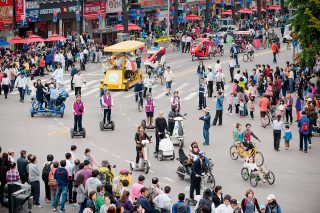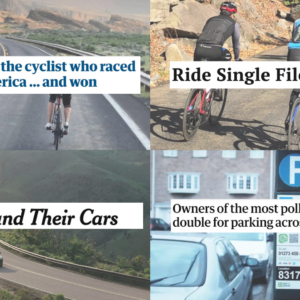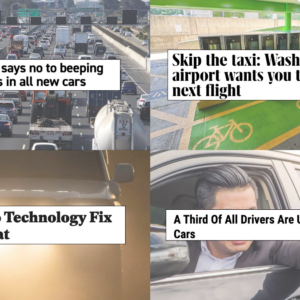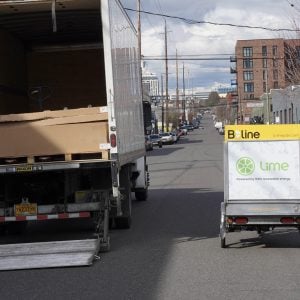
(Photo: The Urban Idea)
Happy Memorial Day, Portland. In honor of the holiday, this is likely to be our only post of the day.
Here are the bike-related links from around the world that caught our eyes this week:
Now that’s a demo: A South Korean neighborhood banned cars for a month in order to see what would happen.
Bikes vs. stress: Bike commuters are 40 percent less stressed when they arrive at their destination than car or public transit commuters, a U.K. study of heart and breathing rates found.
“Sky garage”: A $560 million luxury skyscraper north of Miami will “incorporate the single-family-home garage concept” by hoisting people’s cars into the air so they can keep it next to their unit.
Floating bus stops: Biking and transit advocates should team up to promote bike lanes that run to the right of bus stops, says Streets.mn.
E-bike sharing: Milan’s 3,600-bike sharing system now has 1,000 e-bikes, creating the world’s first system that lets both park at the same docks. (The news comes after Birmingham, Ala., was planning to become the first U.S. city with an e-bike share system.)
Atlanta biking: After years of pressure from advocates, Atlanta is hiring its first “chief bicycle officer.”
Cargo bike parking: The low staples in this Malmo, Sweden, parking garage are still the best we’ve seen:
Cargo bike parking at the train station in Malmö pic.twitter.com/Ikkh2ZO12H
— Green Lane Project (@GreenLaneProj) May 19, 2015
Traffic myths: #3 on writer Tom Vanderbilt’s five-point list is “changing lanes will get you there faster.”
Traffic death: Nobel-winning mathematician John Nash and his wife, subjects of the movie “A Beautiful Mind,” died in a New Jersey traffic collision Saturday as their taxi lost control while changing lanes.
Female mobility: Fuel shortages in war-torn Yemen are fostering bicycle use among women, and some locals are scandalized.
Biking’s monoculture: In the white-guy-dominated industry of fancy bikes, “it’s time to acknowledge that if you’re using sex to sell your product, what you are doing is lazy and harmful,” writes bike racer Patrick Brady.
Advertisement
Hillsboro paths: The city is nearing approval of a plan to add 70 miles of bikeable off-street paths in the coming decades, tripling its current total.
FHWA backs protected lanes: A new federal design guide has formally endorsed protected bike lanes as desirable ways to make biking attractive to more people.
Tsk tsk: A Springfield man who hit and killed three children in a crosswalk with his pickup truck won’t get a criminal charge, but he did get a traffic citation for careless driving.
Idle wheels: The average UK city dweller’s car is driven for 4.6 hours a week, which means it’s parked for 97 percent of its life.
Seattle downgrade: The annual Bike Score ranking dropped Seattle out of its top 10 most bikeable cities. The executive director of advocacy group Seattle Neighborhood Greenways says that’s “healthy.”
Chicago infrastructure: As Mayor Rahm Emanuel’s second term starts, Chicago is building its first curb-protected bike lane and has various other advanced bike lane projects on tap.
“A new road order”: Seattle’s Department of Transportation filmed advice from NYC and Chicago transportation heroes Janette Sadik-Khan and Gabe Klein at an event about the city’s transportation future.
Rack theft: West Seattle sees a bike theft by rack removal.
And in your very short video of the week: your one-use, $330 “invisible bicycle helmet” doesn’t seem quite so cool now, does it?
If you come across a noteworthy bicycle story, send it in via email, Tweet @bikeportland, or whatever else and we’ll consider adding it to next Monday’s roundup.






Thanks for reading.
BikePortland has served this community with independent community journalism since 2005. We rely on subscriptions from readers like you to survive. Your financial support is vital in keeping this valuable resource alive and well.
Please subscribe today to strengthen and expand our work.
I would love to see floating bus stops all over Portland. Additionally, could be a catchy hashtag… #floatingbusstops
this was unfortunately a stumbling block in the redesign of williams, and the result is the left hand bike lane
Se Hawthorne at 6th, eastbound.
And 12th/Hawthorne in front of Burgerville.
Cycling and stress: fun to see a study that shows this. I am not the least surprised.
In other news, are we going to get the ‘subscribe to the comments’ button back one day? I really miss it.
Thanks.
I’m glad a study has been done, but in my experience (which is not scientific at all), I am more stressed at the end of my commute home/beginning of my commute to work because I have no shoulder/bike lane and have to mix in with impatient drivers who seem intent on hitting, hurting, or scaring me. And that’s just the last mile home, and it’s worse now that the City of Tigard changed the bike lanes by Fowler Middle School to parking lanes instead of enforce the parking laws already in place.
Hah!!! The video! 🙂 Haha!
They should make those to look like an Elvis wig.
Thank you very much.
I love this idea. 🙂
Laughed my ass off at it. Can’t believe how squeamish the idea and appearance of a real cycling helmet makes people–it’s why I will always wear the loudest-colored, racer-looking-dorky thing I can find.
Several things leaped out at me in the Streetsblog article about Chicago’s bike infrastructure. Here are some of the points that made me go “C’mon, Portland! Take a page from Rahm Emmanuel’s Bike Book!”:
–“Our focus this year is really going to be on bridging the gaps in the bike network.”
–The new curb[-protected bike lane]s are being put in as part of a resurfacing project.
–“Over the past four years, we’ve put in a lot of bike lanes in a short time, but it was always our goal to upgrade them over time. We’re piloting curb separation here. Experimenting with concrete is something we want to do moving forward whenever we can.”
–…there was no public announcement about the Sacramento [Street] curbs…
–“One of the goals of the [curb-protected bike lanes’] concrete separation is to encourage drivers not to park in them”
–The local business association previously opposed [buffered bike lanes]. However, the group has dropped its opposition, and the buffered lanes may go in by fall.
–[the state DOT] had previously prohibited CDOT from installing protected bike lanes on state roads within the city. However, the state transportation department lifted the ban [after a fatal car-on bike crash] and is actually spearheading and funding the Clybourn curb-protected lane project.
It’s an inspiring read! Kind of a wish-list for Portland.
Sounds like whoever is in charge over there is taking some leadership. Who’d have guessed that you could get stuff done by expending some political capital?! Thanks for the summary.
Emanuel is a cyclist–he is a triathlete, so he’s putting some significant miles on. The city has a cycling heritage from way before him, too.
But a triathlete is only one-third of a cyclist… 😉
Tom Vanderbilt’s myths – brilliant!
I liked this one on suburban cities:
http://fivethirtyeight.com/features/how-suburban-are-big-american-cities/#fn-3
would urge anyone to follow the links from brady’s article to the “pinkgate” discussion and ultimately to amanda brady’s blog post on why she quit pinkbike.
http://blog.amandabatty.com/2015/05/why-im-leaving-pinkbike.html
this is important stuff
On the cargo bike parking in Malmo: Yeah, it looks great for a few riders with giant cargo bikes, but each space is like half as big as a car parking space! More important is the huge amount of tightly-packed parking for smaller bikes. Lots of bikes parked in a little space is the unmistakeable sign of a mass cycling culture.
Are you saying that people shouldn’t own cargo bikes? Or they can own them, they just shouldn’t expect to be able to park them somewhere? Do you have children?
No, I’m not saying people shouldn’t own cargo bikes. Actually I think it’s great that some cargo bike parking exists at the train station in Malmo! But the emphasis on this blog on cargo bike parking is nuts. This blog is one of a group in today’s cycling advocacy that will criticize any space-efficient bike parking arrangement and praise super-spacious bike parking (see any article on Franklin High School), ignoring all the bikes chained to fences and railings where biking is popular and parking is insufficient. Anyone that actually needs the extra space gets nothing out of it if the spaces are all taken!
The Malmo station gets it right. A ton of space-efficient parking, and a little bit of cargo-bike parking in the middle for the people that need it. Coverage here misses the importance of the space-efficient parking, as it does routinely, and on this basis recommends local solutions that can’t possibly scale up to a mass cycling culture… and that fail, today, whenever cycling becomes popular.
Except for in a place like Malmo (which is effectively suburban Copenhagen) there are more than a few cargo bikes about, cars are smaller than here, and a high premium is place on cycling as practical transport. Makes perfect sense.
I was skeptical about the floating bus stops on Dexter Ave in Seattle. I feared that it would create conflicts between bikes and bus riders in a hurry to catch their bus crossing the bike lane. So far those fears have been unfounded, and the lack of bus conflicts has made the bike lane work lots better
The Hövding offers no face protection. That’s a missed opportunity.
There’s the schadenfreude of that silly €300 contraption misfiring, but a styrofoam hat isn’t much different except in price. Both of them are “one-use”, and the hope is for less than that.
“but a styrofoam hat isn’t much different except in price.”
Um, with helmet giveaway events, and Craigslist and—I just checked REI and found some for $19—I don’t think you can really dismiss the difference in price so easily. $330 is more than I’ve spent on a bike in almost thirty years.
And I guarantee you that I’ve never used up my helmet when putting on my jacket. So there’s that.
It goes without saying that there’s (usually) a significant difference in price.
The point is that no helmet or helmet-like object gets more than one “use”, and they’re all pretty much equally ridiculous. This particular ridiculous device just happens to have a JRA (just riding along) failure with hilarious documentation.
Well, I guess I just see this differently.
(1) The early bike helmets which had a much thicker outer shell (and I think the more spherical Nutcase style helmets now popular reproduce this feature) could be dropped without compromising their future functionality. And I don’t know anyone who hasn’t dropped their helmet on occasion. = durability
(2) I think helmets are one case where mass production bringing the price down to a negligible level shunts this object into a category where loss or accidental damage does not impact (ha!) my ability to keep using one. When you up the price into the stratosphere, and make the thing into an electronic wonder, the sensitivity to accidental deployment is just one more layer of foolishness. = replacement cost
(3) I think of this difference as akin to telephones. Once upon a time all I needed was a quarter to make a call from a phone booth. Now we don’t have phone booths anymore and to make an equivalent call I’d need not only a cell phone but some crazy expensive plan. The two are not just variations on the same theme; the price differential is so large that they are really two different things. = nonlinearities
From Tom Vanderbilt’s article on traffic myths:
…those highways were able to achieve “maximum throughput” — pushing the most cars through one segment of road in a given time — at speeds that were roughly 80 percent of the posted speed limit of 60 mph. Why? At higher speeds, drivers need to allow more “headway” between vehicles, meaning more space is required per vehicle. And faster-moving traffic tends to break down more quickly, with more severe “shock waves”; it takes a lot longer to recover from a traffic jam than to get into one.
In other words, to optimize traffic flow on the highway and all the positive consequences of that, it’s just fine to drive in the left (so-called “passing”) lane at the speed limit and ignore the fools behind flashing their lights because I’m slowing them down on their mad quest to exceed the legal speed limit and slow everyone else down. Unless, of course, the flashing lights are blue and red. In that case, move aside.
Is there documentation certifying that you are the appointed freeway fast lane speed limit enforcer? Left lane plodders may have self-righteous justification for their driving style but speeders will speed and their risky behavior is less risky when they are not zipping in and out of lanes or being goaded into a road rage event. Move over and let them pass.
Victim blaming.
Victim blaming? Elaborate, because I just don’t see it. You are going the speed limit in a multi lane highway and someone wants to pass going over the speed limit. I don’t see how there is a victim by having slower traffic allow passage to faster traffic.
The whole concept of victim blaming is serious when cyclists are denied due process because cultural zietgiest allows them to be considered incapable of good decision making because they don’t have a helmet, or when a rape victim is deemed responsible for her assault because of the clothes she wears. I feel, in the context of speaking out to allow faster traffic to pass, the term victim blaming is tossed about in a caviler manner perhaps to load me with some guilt. That is a fail.
Here’s what you wrote earlier: …speeders will speed and their risky behavior is less risky when they are not zipping in and out of lanes or being goaded into a road rage event. I take that to mean that I need to move aside to allow speeders to speed, or otherwise they will be even more reckless and they will endanger lives, possibly my own. So if a speeder clips my front bumper as he tries to weave past me doing 10 MPH over the legal limit, and I crash, it’s my fault because…I was blocking him in his attempt to speed… because I “goaded” him. That’s victim blaming, don’t you think?
Look, there are a couple of ways to look at this. The first is that since we are both breaking the law (I by failing to keep to the right, you by failing to drive at or below the speed limit) neither one of us has the right to complain about the other. We’re both outlaws, and outlaws don’t get to complain about other outlaws. Hypocrisy.
I look at it this way: by driving at the speed limit in the left lane I am endangering no one. If you develop road rage and weave in and out and kill somebody or yourself because you somehow felt the need to speed, that’s your fault. And speeding can and often is a factor in crash lethality. Maneuverability at highs speeds, braking distance, reaction times, etc.
And now it appears we have data showing that speeding doesn’t really improve the efficiency of driving on highways, and that it may actually diminish it (see the article for details). So then, why exactly should people who are driving safely (i.e. without excessive speed for that stretch of road, with at least a three second separation from car in front, paying attention, etc, etc) get out of the way of amped-up inpatient risk-taking speeders? What’s the societal benefit to that?
Slow down, Gramps. Relax. Chill. Go By Train.
It may sound like I drive a Smokey & the Bandit thunder-chicken Trans Am Firebird with “Foxy Grandpa” personalized license plate, but I am a typical schlub with a normal ride who just happens to drive the speed of traffic. On freeways that is invariably about 5-7 over the posted speed limit. I am not an amped=up, impatient risk taking speeder, but i do find that passive-aggressive vigilante speed enforcement wannabes are frustrating. I can not know that they are serving a social good based on obscure data. To me it looks like they are either trying to obstruct the flow of traffic and thereby engaged in a negative behavior, or they are oblivious to the concept of “fast lane” and thereby bad drivers.
“…Left lane plodders may have self-righteous justification for their driving style but speeders will speed and their risky behavior is less risky when they are not zipping in and out of lanes or being goaded into a road rage event. Move over and let them pass.” Granpa
People driving in the left lane at the speed limit or maybe five to ten miles above, are not “…Left lane plodders…”. The left lane is a passing lane, not, as some seem to think: a ‘speeding’ lane.
When traffic on the road is fairly heavy, it’s not too difficult to keep the lateral distance between left and right lane vehicles small enough that speeding tendency is handicapped; that’s if both left and right lane traffic are disinclined to allow speeders to intimidate them into yielding their lane even though they are traveling the speed limit.
RE: Korean ecomobility festival. Where in Portland could this be done?
Sunnyside Neighborhood.
Pearl District. Might not be easy. But it needs to happen there. Too many self-entitled drivers.
“They simply said it couldn’t work.”
Better question: where in Portland would a majority, preferably a super-majority, choose to relinquish their personal access to their streets?
You mean car access.